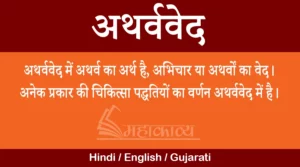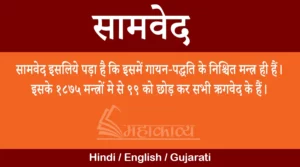Read Yajurveda in English
Yajurveda (Yajurveda in English) is famous as the second Veda among the four Vedas. Which is believed to have been composed by a mixture of Rigvedic hymns, because 663 mantras of Rigveda are also found in Yajurveda. Still, it cannot be said that both are the same book. Mantras of Rigveda are verse, while the Gadyatiko Yaju of Yajurveda, as well as many mantras are similar to Rigveda.
Yajurveda is a methodical text, which was compiled in the priesthood system for performing rituals like Yagya etc. That is why even today most of the mantras of various rituals and rituals are from Yajurveda. Yajur has been more popular than Yajurveda because it is related to karma etc. There are 101 branches of Yajurv Veda, but the main two branches are more famous, Krishna Yajurveda and Shukla Yajurveda, they are also called Taittiriya and Vajasaneyi Samhita respectively. Of these, the Taittiriya Upanishad is considered to be older than that, although both have the same content. Yes, there is some difference in the order of Krishna Yajurveda and Shukla Yajurveda. Shukla is more systematic than Yajurveda. There are some such mantras in this, which are not in Krishna Yajurveda.
When and how Yajurveda (Yajurveda in English) got divided into two Samhitas, it is not available in authentic form, yes, an interesting story is definitely prevalent in this context. It is said that Vaishampayana, the disciple of Vedavyasa had 27 disciples. The most meritorious among them was Yajnavalkya. Once Vaishampayana had invited all his disciples for some sacrifice. Some of those disciples were not fully skilled in rituals.
Therefore Yajnavalkya refused to accompany those unskilled disciples. Due to this, there was a dispute among the disciples. Then the knowledge that Vaishampayana had taught Yajnavalkya got back from Yajnavalkya what he had taught. Yajnavalkya also came in a rage and immediately vomited Yajurveda. The particles of Vidya were stained with the blood of Krishna Varna.
Seeing this, the other disciples became pheasant and ate those particles. The branch of Yajurveda developed by these disciples was called Taittiriya Samhita. After this incident, Yajnavalkya worshiped Surya and again received Yajurveda from him. Surya had given initiation to Yajnavalkya by becoming an eagle (horse) in the Yajurveda, hence this branch was called Vajasaneyi.
It is impossible to tell how true this story is and how much is false. Some scholars call it fiction and some myth. Whatever be the case, it is so certain that Yajurveda is that branch (part) of knowledge (Veda) that is dominated by rituals, on the basis of which the businessmen of religion have done selfishness by fooling the common people for centuries and it is the same even today. Used to be.
Today, when the number of Sanskrit knowers in the country has been counted, even among those who know Vedic Sanskrit, then it has become necessary that along with other Vedas (Vedic texts) Yajurveda should also be translated into simple Hindi. It should be presented, so that even ordinary readers can understand that what is the real meaning and meaning of the mantras of this Veda, which determine the importance of rituals like sacrifice, social rites, etc..
The reason is that from the beginning, Yajurveda (Yajurveda in English) has been considered related to rituals, so almost all the ancient masters have interpreted its mantras in the context of rituals, among these masters Uvat (1040 AD) and Mahidhar (1588 AD). Prominently noteworthy are the commentaries of K. K., who wrote commentaries on the Shukla Yajurveda. Those commentaries are still available and accepted by various scholars. Even after seeing the commentary of Acharya Uvat, even Acharya Sayan has not used his pen on the commentary of Yajurveda.
The word ‘Yajush’ means ‘Yajna’. Yarjuveda is basically a ritual text. Its composition is believed to be in Kurukshetra. In the Yajurveda, a tableau of the religious and social life of the Aryans is found. This text shows that the Aryans had moved on from the ‘Sapta Saindhavas’ and were becoming indifferent to natural worship. The hymns of Yarjuveda were recited by a priest named ‘Adhvhurya’. In this Veda, the methods of performing various types of yagyas are mentioned. It is written in both prose and verse. The prose is called ‘Yajush’. The last chapter of the Yajurveda is the Ishavasya Upanishad, which deals with spiritual thinking. This minor Upanishad is considered primitive among the Upanishads because apart from this, no other Upanishad is a part of the Samhita.
Table of Contents
ToggleYajurveda has two main parts:
1 Shukla Yajurveda
2 Krishna Yajurveda
Other features of Yajurveda:
Yajurveda is prose.
The prose hymns uttered in the Yagya are called Yajus.
The poetic hymns of Yajurveda are taken from Rigveda or Atharvaveda.
There are very few free verse mantras in these.
Yajurveda contains rules and regulations for Yagyas and Havans.
This book is ritualistic.
If the Rigveda was composed in the Sapta-Sindhu region, then the Yajurveda was composed in the region of Kurukshetra.
This book throws light on the social and religious life of the Aryans.
The tableau of Varna system and Varnashram is also in it.
Yajurveda is the head of Yagyas and rituals.
Read here in one click ~ Yajurveda in Hindi





 Download the Mahakavya App
Download the Mahakavya App